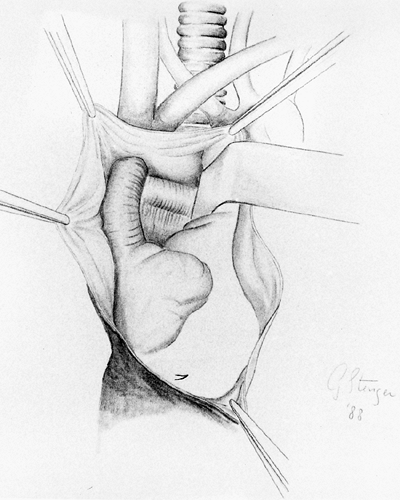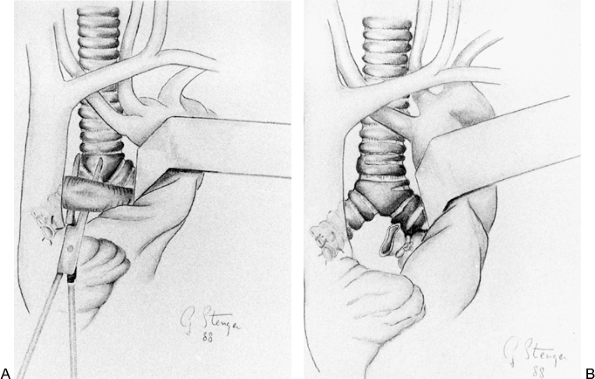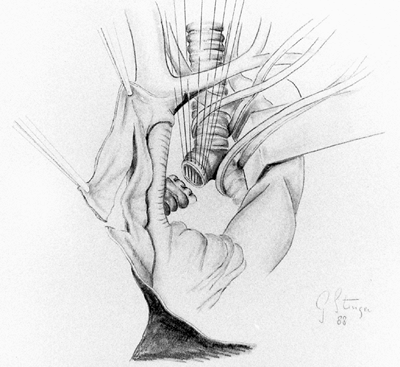26 - General Features of Pulmonary Resections
Editors: Shields, Thomas W.; LoCicero, Joseph; Ponn, Ronald B.; Rusch, Valerie W.
Title: General Thoracic Surgery, 6th Edition
Copyright 2005 Lippincott Williams & Wilkins
> Table of Contents > Volume I - The Lung, Pleura, Diaphragm, and Chest Wall > Section VII - Pulmonary Resections > Chapter 34 - Median Sternotomy and Parasternal Approaches to the Lower Trachea and Main-Stem Bronchi
Chapter 34
Median Sternotomy and Parasternal Approaches to the Lower Trachea and Main-Stem Bronchi
Aart Brutel de la Rivi re
Henry van Swieten
Median sternotomy as an approach to the main-stem bronchi is mainly indicated in the surgical treatment of bronchopleural fistula after pneumonectomy. Other indications include main-stem bronchial tumors, which require only sleeve resection of the bronchus. In patients requiring more extensive resection of the carina, the disadvantage of not being able to mobilize the left main bronchus precludes this approach. On the right side, however, pericardial release and full mobilization of the hilum can be accomplished safely. Rare indications include patients who require complex completion pneumonectomy in which, as a first step, transsternal ligation of the main vessels and bronchial closure permit safe removal of the remaining lung through a second lateral incision.
Median sternotomy allows preparation of the greater omentum by slightly extending the incision into the abdomen. The omentum, brought up into the chest through the pericardial sac, can easily reach the main carina and plays a major role in supportive surgical techniques to promote healing of bronchial suture lines.
Median sternotomy as a means of access to the pulmonary hilum was first described by Padhi and Lynn (1960), who reported the anterolateral approach. Abruzzini (1961) described the transsternal route to the main bronchi without opening the pericardium, and Perelman (1998) subsequently popularized the technique, incorporating Bogush's advice to go through the pericardium. Azorin and co-workers (1996) reported video-assisted surgical closure of a postpneumonectomy bronchopleural fistula, approaching the main carina as in cervical mediastinoscopy.
In this chapter, we describe the median sternotomy and parasternal approaches for the management of persistent main-stem bronchopleural fistula after pneumonectomy. For other treatment strategies, see the publications of Pairolero (1990) and Puskas (1995) and their associates and Chapter 59.
TECHNIQUES OF TRANSPERICARDIAL APPROACHES
The patient lies supine on the operating table. Selective ventilation to prevent flooding of the remaining lung should be achieved either by selective bronchial intubation using a long endotracheal tube or by the use of a double-lumen tube. Selective intubation with a long tube allows the tube to be pulled back far above the main carina at the time of actually closing the bronchus, thereby diminishing tension on the suture line by removing the internal stent, that is, the tube.
Intravenous vasodilators lower blood pressure and thus allow safe manipulation of the ascending aorta. A large-bore nasogastric tube facilitates esophageal identification during dissection. A single dose of antibiotic prophylaxis is used.
After complete median sternotomy, performed with an oscillating saw to prevent damage to the lung, care should be taken to avoid entering the pleural space. In patients with long-standing fistulae, the combination of severe hyperinflation and retraction of the mediastinal structures toward the operated side may cause significant displacement of the heart and great vessels. For left-sided fistulae, this may be an indication to use the parasternal route.
The pleural fold is dissected, and the pericardium is opened longitudinally; stay sutures facilitate exposure. The tracheal bifurcation is reached between the superior vena cava and the ascending aorta laterally and between the innominate vein and the pulmonary artery at the craniocaudal borders. This approach also allows lymph node sampling of the main carina and its surroundings, for example, Naruke
P.534
stations 7 and 3. A handheld retractor should gently keep the aorta away to the left; a stay suture on the right atrial appendage brings it to a more caudal, stable position in the operative field (Fig. 34-1). Access to the main carina is obtained by opening the dorsal pericardium (Fig. 34-2A).
Right Main Bronchus
First, the residual right pulmonary artery is reamputated behind the ascending aorta, immediately at its take-off from the main pulmonary artery (see Fig. 34-2B). Only the proximal end is closed (5.0 running Prolene suture). If retraction of the great vessels to the right is extreme, the main carina can also be approached to the left of the ascending aorta.
During mobilization, care should be taken to avoid injury to the left recurrent laryngeal nerve, esophagus, and azygos vein. The right bronchus is dissected and encircled. If the bronchial stump is too short to allow safe, tension-free closure, a carinal resection should be done (see Chapter 30), or, alternatively, a partial, wedgelike, carinal resection is performed as described by Fahimi and co-workers (2000).
Dissection should be limited to avoid interruption of blood supply, but a tension-free suture line is essential. Encircling the distal trachea or left main bronchus (or both) is optional (Fig. 34-3). If dense adhesions preclude going around the bronchus, it is transected stepwise in a ventrodorsal direction. The bronchus is closed with resorbable suture material: 3.0 Vicryl or 3.0 polydioxanone suture. Although automatic stapling devices are used to close the airway, their introduction and manipulation in the operative field require considerable additional space, which is usually not available in this type of operation.
 |
Fig. 34-1. The ascending aorta is retracted to the left with a retractor. The right pulmonary artery is visualized between the superior vena cava to the right and the retractor to the left. |
Before tying the sutures, the endobronchial tube is pulled back high above the carina. The distal bronchial stump should be resected, or the bronchial mucosa destroyed by electrocautery, because it may cause mucous discharge into the surrounding tissue.
Adequate coverage of the proximal stump is important: A pericardial fat pad, thymic remnants, or the omentum can be used. If the pericardium is to be closed (standard in our hands), an intrapericardial drain is left, as is a substernal drain. The patient is extubated on the table.
Left Main Bronchus
On the left, the residual bronchus (i.e., the stump) is usually longer, and the need for more extensive surgery is rare.
Transsternal Approach
After opening the dorsal pericardium between the aorta and the vena cava, the main carina is reached. The left main bronchus is dissected, paying attention to the recurrent laryngeal nerve. If dense adhesions do not permit encircling the bronchus, it should be transected gradually. Closure and handling of the distal stump are the same as those for the right distal stump.
Parasternal Approach
In patients with a left-sided fistula and severe retraction of the mediastinum to the left, transpericardial access can also be obtained by an anterolateral thoracotomy in the second or third intercostal space or by a parasternal approach, which consists of a vertical skin incision followed by subpericostal resection of the second and third cartilages.
The thickened pleural reflection is dissected, and the pericardium is opened longitudinally, anterior to the phrenic nerve. Transsection of the left pulmonary artery and closure of the main pulmonary artery with 5.0 Prolene suture, thereby severing Botallo's ligament, facilitates exposure of the left main bronchus. If additional mobilization is required, intrapericardial transection of the pulmonary veins is useful.
Primary vascular control is the key to a safe operation. Closing the bronchus is as indicated; identification of the
P.535
P.536
bronchial stump may be facilitated by transillumination, using a fiberoptic bronchoscope.
 |
Fig. 34-2. A. The dorsal pericardium is opened, and the right pulmonary artery is encircled. B. After reamputation of the right pulmonary artery, behind the ascending aorta, the bronchus is dissected. |
 |
Fig. 34-3. The distal trachea and the left main bronchus are encircled, and the right main bronchus is transected and resutured. Note the pericardial flap prepared ventral to the superior vena cava to cover the newly created stump. |
PERIOPERATIVE MANAGEMENT
Space infections in patients with active empyema should be properly controlled before operating on the airway. The best drainage is obtained by a large, open thoracostomy window. The pleural space is packed twice daily with gauze soaked in a 0.02% chlorhexidine solution.
The time needed to achieve a clean pleural space can be used to improve the patient's nutritional status using a nasogastric feeding tube. Pretreatment usually requires about 6 weeks. The thoracostomy can be closed 2 weeks after midsternal closure, when cultures taken from the pleural space are negative.
MORBIDITY AND MORTALITY
Intraoperatively, hemorrhage is the most serious complication, occurring in 2% to 5% of patients. Postoperative complications are mostly determined by the preoperative general condition of the patient. Apart from respiratory insufficiency, the most dreaded complication is recurrent fistula. Small recurrent fistulae can be treated conservatively; large fistulae should be approached surgically, if the patient can tolerate the procedure.
The 30-day mortality rate of the operation is reported as 0% to 5.4%. Overall hospital mortality is much higher, reaching 24%. After discharge, no recurrences have been reported.
The long-term prognosis is determined by the original pathology: For cancer patients, survival is related to the extent of their disease; for patients with benign disease, the results are excellent.
PRESENT STATUS OF PARASTERNAL APPROACH
The parasternal approach in itself is simple and effective. In the treatment of postpneumonectomy bronchopleural fistula; however, its place should be carefully defined.
Early fistulae (within 2 weeks of resection) without empyema can be resutured through the ipsilateral hemithorax, buttressing the new stump with a vascularized pedicle or the omentum.
Small, chronic fistulae can usually be obliterated without direct bronchial surgery (e.g., using biological glue) or by the use of a thoracostomy window with repeated packing for a period of 4 to 6 weeks.
Large fistulae with concomitant empyema should be treated surgically, either through the ipsilateral chest with liberal use of muscle flaps or omentum or by the transpericardial approach. The transpericardial approach is most useful when there are contraindications to an ipsilateral approach or when a carinal resection is required.
The technique has the advantage of operating in an aseptic, undisturbed field with well-defined anatomy; however, one should be highly selective using this procedure.
REFERENCES
Abruzzini P: Trattamento chirurgico delle fistole del bronco principale consecutive a pneumonectomia per tubercolosi. Chirur Torac 14:165, 1961.
Azorin JF, et al: Closure of a postpneumonectomy main bronchus fistula using video-assisted mediastinal surgery. Chest 109:1097, 1996.
Fahimi H, et al: Wedge carinal resection for closure of the main bronchus after pneumonectomy. Ann Thorac Surg 70:987, 2000 Padhi RK Lynn RB: The management of bronchopleural fistulas. J Thorac Cardiovasc Surg 39:385, 1960.
Pairolero PC, et al: Postpneumonectomy empyema. J Thorac Cardiovasc Surg 99:958, 1990.
Perelman MI: Surgery for chronic bronchial fistulas after pneumonectomy. J Cardiovasc Surg 39:137, 1998.
Puskas JD, et al: Treatment strategies for bronchopleural fistula after pneumonectomy. J Thorac Cardiovasc Surg 109:989, 1995.
Reading References
Brutel de la Rivi re A, et al: Transsternal closure of bronchopleural fistula after pneumonectomy. Ann Thorac Surg 64:954, 1997.
Ginsberg RJ, et al: Closure of chronic postpneumonectomy bronchopleural fistula using the transsternal transpericardial approach. Ann Thorac Surg 47:231, 1989.
Ginsberg RJ, Saborio DV: Management of the recalcitrant postpneumonectomy bronchopleural fistula: the transsternal transpericardial approach. Semin Thorac Cardiovasc Surg 13:20, 2001.
Stamatis G, et al: Transsternal transpericardial operations in the treatment of bronchopleural fistulas after pneumonectomy. Eur J Cardiothorac Surg 10:83, 1996.
EAN: 2147483647
Pages: 203